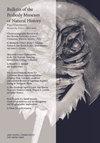东半球甲壳类动物化石记录综述
IF 0.9
4区 哲学
Q2 BIODIVERSITY CONSERVATION
引用次数: 59
摘要
摘要泛甲壳类动物在旧大陆有着丰富的化石记录,从白垩纪早期(豪特里夫阶)到全新世。该分支很可能起源于白垩纪早期的亚洲,但到白垩纪晚期从那里传播到美洲和欧洲,到始新世传播到印度和澳大利亚,到新第三纪传播到非洲-阿拉伯。亚洲晚白垩世(马斯特里赫特阶)存在一个单一的泛cyclanorbine,这为三齿冠的年龄提供了最低限度的估计。晚白垩世期间,亚洲的多样性相对较高,但随后的强烈下降可能是一种保护偏见,因为现存的动物群相对丰富,尤其是在整个亚洲。在新第三纪的过程中,三趾虫的范围在欧洲向南收缩,现在该群体正在当地灭绝。该组织现在同样缺席了阿拉伯和澳大利亚的比赛。对180个已命名的旧大陆分类群进行分类审查,发现42个有效名词、38个无效名词、88个dubia名词、11个nuda名词和1个抑名名词。本文章由计算机程序翻译,如有差异,请以英文原文为准。
A Review of the Fossil Record of Old World Turtles of the Clade Pan-Trionychidae
Abstract Turtles of the clade Pan-Trionychidae have a rich fossil record in the Old World, ranging from the Early Cretaceous (Hauterivian) to the Holocene. The clade most probably originated in Asia during the Early Cretaceous but spread from there to the Americas and Europe by the Late Cretaceous, to India and Australia by the Eocene, and to Afro-Arabia by the Neogene. The presence of a single pan-cyclanorbine in the Late Cretaceous (Maastrichtian) of Asia provides a minimum estimate for the age of the trionychid crown. As preserved, diversity was relatively high in Asia during the Late Cretaceous, but the subsequent, strong decline is likely a preservational bias, as extant faunas are relatively rich, especially throughout Asia. The range of trionychids contracted southward in Europe over the course of the Neogene, and the group is now locally extirpated. The group is now similarly absent from Arabia and Australia. A taxonomic review of the 180 named Old World taxa finds 42 nomina valida, 38 nomina invalida, 88 nomina dubia, 11 nomina nuda, and 1 nomen suppressum.
求助全文
通过发布文献求助,成功后即可免费获取论文全文。
去求助
来源期刊

Bulletin of the Peabody Museum of Natural History
BIODIVERSITY CONSERVATION-ECOLOGY
CiteScore
2.40
自引率
0.00%
发文量
6
审稿时长
>12 weeks
期刊介绍:
The Bulletin of the Peabody Museum of Natural History publishes original research based on specimens, artifacts and related materials maintained in the collections of the Yale Peabody Museum of Natural History’s curatorial divisions. The Bulletin is published twice a year, in April and October.
 求助内容:
求助内容: 应助结果提醒方式:
应助结果提醒方式:


